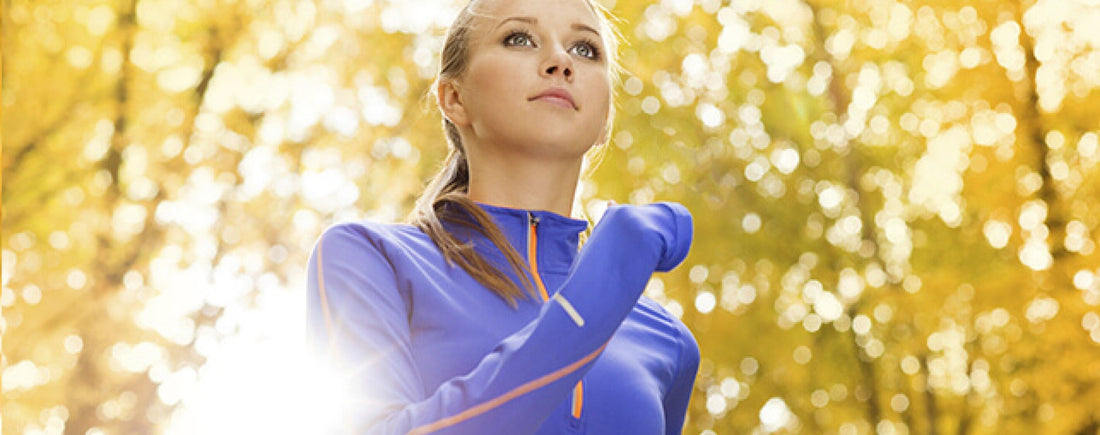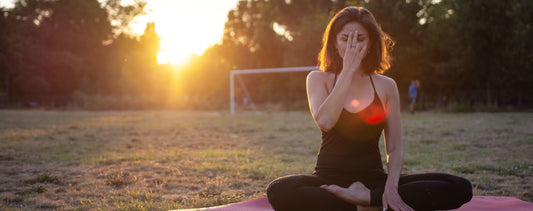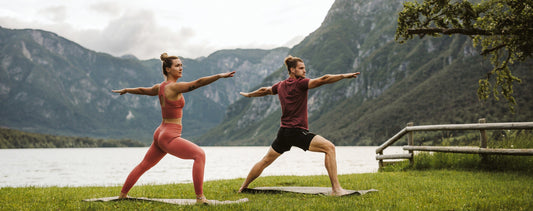Doing yoga before a run can help you get stronger muscularly and mentally, prevent injuries, and even improve your speed. Try these five yoga poses before your next trek on the pavement or trail.
How to do them: Lie on your back with your feet wide apart and your knees together. Close your eyes and take some deep breaths. Allow your mind and body to connect through breath awareness.
Bring your knees up so they’re in line with your hips. Your thighs will be perpendicular to the mat and your shins will be parallel to the mat.
Interlace your fingers behind your head. If you have any neck issues, keep the back of your head resting on the mat. On your inhale, lift your head, neck, and possibly shoulder blades off the earth. Exhale and extend your right leg straight as you bring your shoulder towards your left knee, keeping your left thigh perpendicular to the mat. Inhale to come back to center and switch legs on your exhale. Keep the movement connected with your breathing, contracting your abdominal muscles on the exhale. Repeat 15 times.
How to do it: Lie on your back with your legs bent, and your feet about hip-bone distance apart and somewhat parallel to each other. Extend your arms down by your sides near your waist. You should just be able to touch your heels with your hands.
Root down through all four corners of your feet, especially your big toe mound sides. There is a tendency to disengage the adductor muscles and rotate the legs externally, resulting in compression in the lower back and losing your foundation of the feet.
Lengthen your tailbone as you inhale, and lift your sacrum and lumbar spine off the earth. Notice if your knees have splayed out. Keep your adductors engaged and your knees right on top of your ankles.
Interlace your fingers behind your back if this is comfortable. Otherwise, keep your arms extended by your side. Start to lift your chest as you rotate the head of your arm bones back, spreading your collarbones. Relax your neck, jaw, and face. Breathe deeply. Stay for about five cycles of breath and lower down. Repeat three times.
How to do it: Stand with your feet about hip-bone distance apart and somewhat parallel. Root down through all four corners of your feet and distribute your weight equally onto those four corners.
Bend your knees and extend your arms down by your sides. Brush the earth with your fingertips. Keep your hips low and your tailbone lengthening down. There is a tendency to arch the lumbar spine in this pose. Engage your abdominal muscles and extend your arms overhead. If you have any shoulder injuries, keep the arms extended straight ahead and parallel to the earth.
As you breathe deeply in this pose, notice if there are any areas where you can soften. Bring your awareness to your shoulders, neck, and jaw. There is no need to hold tension there. Stay for about five cycles of breath and repeat.
How to do it: Start standing with your feet about hip-bone distance apart, just like in chair pose.
Inhale and extend your arms overhead. Find length in your side waist from your hips to your armpits. Keep that length in your spine as you exhale and hinge at your hip crease extending your arms into a T-shape parallel to the earth. Your torso will eventually be parallel to the earth creating a 90-degree angle between your torso and legs.
Engage your arms and create your own resistance here. Your arms will support you in this balance pose. If you’re having trouble balancing, place one hand at the wall lightly. Keep your shoulders and hips square to the earth.
Point your left toe back behind you. Keep breathing deeply. This may be enough to start. If you’re feeling steady, start to lift the left leg. Keep your hips square. There is a tendency to lift the left hip and externally rotate the left hip. Breathe into that right hamstring as you lift your left leg from your left inner thigh.
Flex your left foot and engage your legs. Keep your abdominals drawing in and up. Spread through your collarbones as you lengthen from your left heel all the way through to the crown of your head. Stay for about five deep cycles of breath.
On your inhale, release your left leg back down to the earth while lifting your abdominals and chest back to standing. Release your arms down and repeat the exercise on the other side.
How to do it: Stand with your feet shoulder-distance apart and somewhat parallel. This pose can be done with the feet hip-bone distance apart or even together, depending on the flexibility of your hamstrings. The longer your hamstrings, the closer you can bring your feet together comfortably. Engage the muscles in your legs, drawing the knee caps up.
Inhale as you extend your arms overhead. Exhale to hinge at your hip creases, bringing your chest down toward your thighs. Keep your abdominals engaged and bend your knees. Rest your chest onto your thighs but keep the abdominals lifted. Bend your knees enough so your ribcage can touch your thighs.
Release your finger tips down to the earth and let your head dangle freely. Soften the back of your neck and shoulders. Stay for about eight cycles of breath.
As you inhale, keep the abdominals engaged to protect the lower back and roll all the way up to standing, with your arms and head heavy. Your head should be the last part of your body to roll up.
Find balance anywhere, anytime with the new Chopra App. Download it now for hundreds of personalized guided meditations at your fingertips.
*Editor’s Note: The information in this article is intended for your educational use only and is not a substitute for professional medical advice, diagnosis, or treatment. Always seek the advice of your physician or other qualified health providers with any questions you may have regarding a medical condition and before undertaking any diet, supplement, fitness, or other health programs.
Yogic Crunches
Why Yogic Crunches? Core strength improves your posture, speed, and endurance, and establishes a solid foundation for strength in your entire body. If you’ve had abdominal surgery or are heavily menstruating, avoid this exercise.How to do them: Lie on your back with your feet wide apart and your knees together. Close your eyes and take some deep breaths. Allow your mind and body to connect through breath awareness.
Bring your knees up so they’re in line with your hips. Your thighs will be perpendicular to the mat and your shins will be parallel to the mat.
Interlace your fingers behind your head. If you have any neck issues, keep the back of your head resting on the mat. On your inhale, lift your head, neck, and possibly shoulder blades off the earth. Exhale and extend your right leg straight as you bring your shoulder towards your left knee, keeping your left thigh perpendicular to the mat. Inhale to come back to center and switch legs on your exhale. Keep the movement connected with your breathing, contracting your abdominal muscles on the exhale. Repeat 15 times.
Bridge (Setu Bandhasana)
Why Bridge? Bridge is a backbend that helps strengthen the legs while stretching the back. It also helps to release the muscles and connective tissue around the chest, abdominals, and hip flexors.How to do it: Lie on your back with your legs bent, and your feet about hip-bone distance apart and somewhat parallel to each other. Extend your arms down by your sides near your waist. You should just be able to touch your heels with your hands.
Root down through all four corners of your feet, especially your big toe mound sides. There is a tendency to disengage the adductor muscles and rotate the legs externally, resulting in compression in the lower back and losing your foundation of the feet.
Lengthen your tailbone as you inhale, and lift your sacrum and lumbar spine off the earth. Notice if your knees have splayed out. Keep your adductors engaged and your knees right on top of your ankles.
Interlace your fingers behind your back if this is comfortable. Otherwise, keep your arms extended by your side. Start to lift your chest as you rotate the head of your arm bones back, spreading your collarbones. Relax your neck, jaw, and face. Breathe deeply. Stay for about five cycles of breath and lower down. Repeat three times.
Chair Pose (Utkatasana)
Why Chair? Chair engages the legs and buttocks, and builds heat throughout your body. It’s usually practiced during the warm-up phase of a yoga sequence and is a great way to warm up your body prior to your run.How to do it: Stand with your feet about hip-bone distance apart and somewhat parallel. Root down through all four corners of your feet and distribute your weight equally onto those four corners.
Bend your knees and extend your arms down by your sides. Brush the earth with your fingertips. Keep your hips low and your tailbone lengthening down. There is a tendency to arch the lumbar spine in this pose. Engage your abdominal muscles and extend your arms overhead. If you have any shoulder injuries, keep the arms extended straight ahead and parallel to the earth.
As you breathe deeply in this pose, notice if there are any areas where you can soften. Bring your awareness to your shoulders, neck, and jaw. There is no need to hold tension there. Stay for about five cycles of breath and repeat.
Airplane Pose (Variation of Warrior III, Virabhadrasana III)
Why Airplane? This standing balancing pose strengthens your entire body, especially the feet and ankles. If you have trouble balancing on one leg, lightly place your fingertips on a wall.How to do it: Start standing with your feet about hip-bone distance apart, just like in chair pose.
Inhale and extend your arms overhead. Find length in your side waist from your hips to your armpits. Keep that length in your spine as you exhale and hinge at your hip crease extending your arms into a T-shape parallel to the earth. Your torso will eventually be parallel to the earth creating a 90-degree angle between your torso and legs.
Engage your arms and create your own resistance here. Your arms will support you in this balance pose. If you’re having trouble balancing, place one hand at the wall lightly. Keep your shoulders and hips square to the earth.
Point your left toe back behind you. Keep breathing deeply. This may be enough to start. If you’re feeling steady, start to lift the left leg. Keep your hips square. There is a tendency to lift the left hip and externally rotate the left hip. Breathe into that right hamstring as you lift your left leg from your left inner thigh.
Flex your left foot and engage your legs. Keep your abdominals drawing in and up. Spread through your collarbones as you lengthen from your left heel all the way through to the crown of your head. Stay for about five deep cycles of breath.
On your inhale, release your left leg back down to the earth while lifting your abdominals and chest back to standing. Release your arms down and repeat the exercise on the other side.
Standing Forward Fold (Uttanasana)
Why Standing Forward Fold? Forward Folds lengthen the entire back of the body from your heels to the cervical spine. Runners can incorporate forward folds pre- and post-run as they tend to have strong but tight hamstrings, calves, and Achilles.How to do it: Stand with your feet shoulder-distance apart and somewhat parallel. This pose can be done with the feet hip-bone distance apart or even together, depending on the flexibility of your hamstrings. The longer your hamstrings, the closer you can bring your feet together comfortably. Engage the muscles in your legs, drawing the knee caps up.
Inhale as you extend your arms overhead. Exhale to hinge at your hip creases, bringing your chest down toward your thighs. Keep your abdominals engaged and bend your knees. Rest your chest onto your thighs but keep the abdominals lifted. Bend your knees enough so your ribcage can touch your thighs.
Release your finger tips down to the earth and let your head dangle freely. Soften the back of your neck and shoulders. Stay for about eight cycles of breath.
As you inhale, keep the abdominals engaged to protect the lower back and roll all the way up to standing, with your arms and head heavy. Your head should be the last part of your body to roll up.
Find balance anywhere, anytime with the new Chopra App. Download it now for hundreds of personalized guided meditations at your fingertips.
*Editor’s Note: The information in this article is intended for your educational use only and is not a substitute for professional medical advice, diagnosis, or treatment. Always seek the advice of your physician or other qualified health providers with any questions you may have regarding a medical condition and before undertaking any diet, supplement, fitness, or other health programs.






















